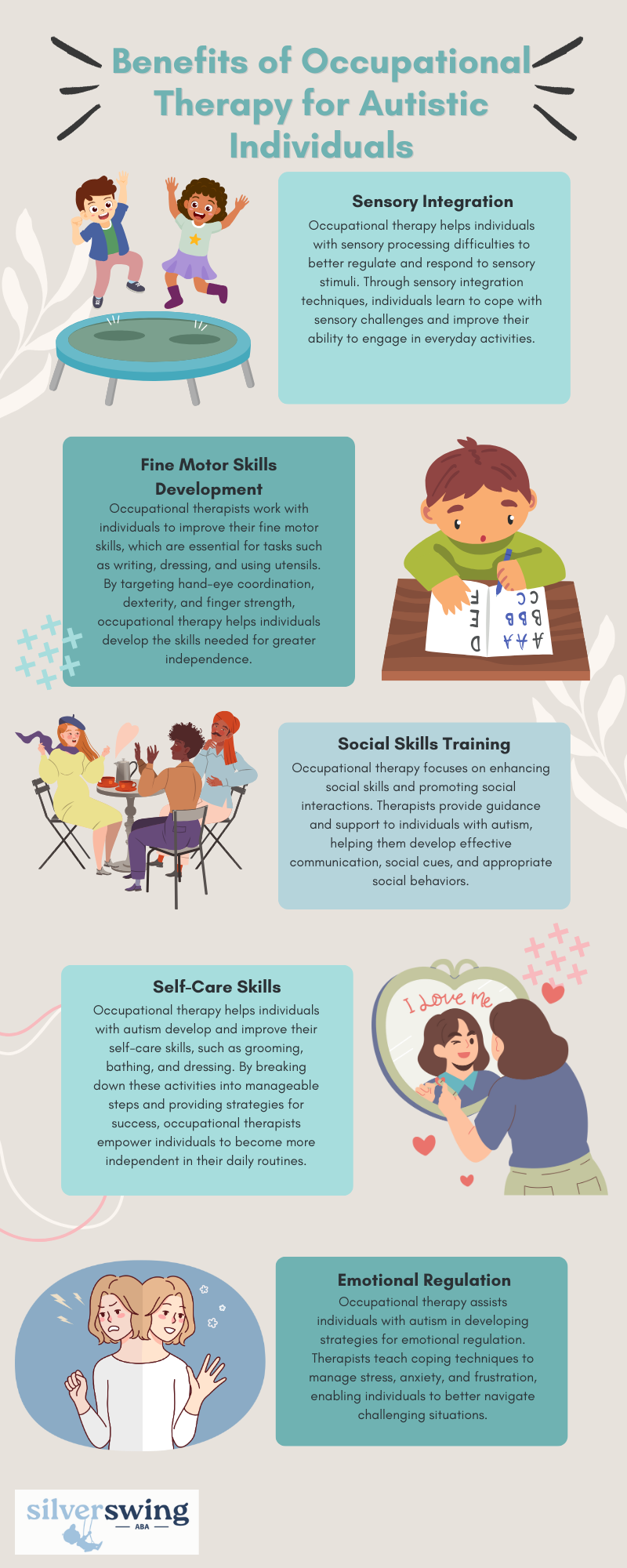Occupational therapy is a client-centered healthcare profession that helps individuals of all ages participate in everyday activities or occupations that are meaningful to them. According to the American Occupational Therapy Association (AOTA), occupational therapy enables people to “achieve their goals, function at their highest possible level, and participate in the activities that matter most to them”.
The World Federation of Occupational Therapists (WFOT) further emphasizes that occupational therapists use a holistic approach to promote health and well-being through engagement in meaningful occupations.
These occupations may include self-care tasks, work or school-related activities, and leisure pursuits.

Goals of Occupational Therapy
The goals of occupational therapy are tailored to meet the specific needs and abilities of each individual. The primary aim is to enhance their independence and quality of life. Some common goals of occupational therapy for individuals with ASD include:
- Developing and improving motor skills, including both fine motor skills (such as grasping objects and using utensils) and gross motor skills (such as walking and jumping).
- Enhancing sensory integration to help individuals process sensory information effectively and regulate their responses to sensory stimuli.
- Promoting social skills development, including communication, social interaction, and the ability to participate in social activities.
- Facilitating activities of daily living (ADL) skills, such as dressing, grooming, feeding, and hygiene.
- Supporting the development of cognitive skills, such as attention, problem-solving, and executive functioning.
- Addressing behavioral challenges and promoting self-regulation.
By addressing these goals, occupational therapy aims to empower individuals with ASD to lead fulfilling lives and participate actively in their communities.
Understanding the definition and goals of occupational therapy sets the foundation for recognizing its significant role in supporting individuals with autism. In combination with applied behavior analysis (ABA) therapy, occupational therapy can provide a comprehensive approach to intervention and help individuals with ASD reach their full potential.

Role of Occupational Therapy in Autism
Occupational therapy plays a vital role in the comprehensive treatment of individuals with autism spectrum disorder (ASD). By addressing the specific needs and challenges faced by individuals with autism, occupational therapy aims to enhance their overall functioning and improve their quality of life.
Occupational therapy offers a range of benefits for individuals with autism. It focuses on developing skills and strategies to promote independence, participation, and engagement in daily activities. Some of the key benefits of occupational therapy for individuals with autism include:

Importance of ABA Therapy
Applied Behavior Analysis (ABA) therapy is another crucial component in the treatment of individuals with autism. ABA therapy focuses on understanding and modifying behavior patterns by applying principles of behavior analysis. It is often used in conjunction with occupational therapy to provide a comprehensive and individualized approach to intervention.
ABA therapy plays a fundamental role in addressing challenging behaviors, enhancing communication skills, and promoting adaptive behaviors. It utilizes evidence-based strategies to teach new skills, increase positive behaviors, and reduce problem behaviors.
Through systematic analysis and reinforcement, ABA therapy helps individuals with autism develop critical life skills and reach their full potential.
The combination of occupational therapy and ABA therapy creates a collaborative and holistic approach to intervention for individuals with autism. By working together, these therapies can address a wide range of needs and provide individualized treatment plans that address the unique challenges faced by each individual.
The goal is to empower individuals with autism to lead fulfilling and independent lives, maximizing their potential for success.

Combining Occupational Therapy and ABA
A collaborative approach that combines occupational therapy (OT) and applied behavior analysis (ABA) can be highly effective for autistic individuals. By integrating these two therapies, individuals with autism can receive comprehensive and individualized treatment plans that address their unique needs.
The collaborative approach between occupational therapy and ABA involves professionals from both disciplines working together to provide holistic support. Occupational therapists focus on enhancing individuals’ daily living skills, while ABA therapists concentrate on behavior modification and skill development.
In this collaborative approach, occupational therapists and ABA therapists communicate and share information to ensure consistency and continuity of care. They collaborate on setting goals, implementing strategies, and monitoring progress. This coordinated effort allows for a more comprehensive and integrated approach to therapy, maximizing the benefits for individuals with autism.
One of the key advantages of combining occupational therapy and ABA is the ability to create individualized treatment plans. Each person with autism has unique strengths, challenges, and goals. By integrating occupational therapy and ABA, therapists can tailor interventions specifically to meet the individual’s needs and promote their overall development.
Occupational therapy focuses on enhancing skills related to daily activities, sensory integration, fine motor skills, and social skills. ABA therapy primarily concentrates on behavior modification, using evidence-based techniques to teach new skills and reduce challenging behaviors.
By incorporating both approaches, treatment plans can address a wide range of areas, including self-care, communication, social interactions, and academic skills.
Individualized treatment plans take into account the specific strengths, interests, and challenges of individuals with autism. They are designed to promote independence, enhance quality of life, and support overall development. Regular assessments and progress monitoring are integral parts of these plans, allowing therapists to adjust interventions as needed and ensure continued progress.




